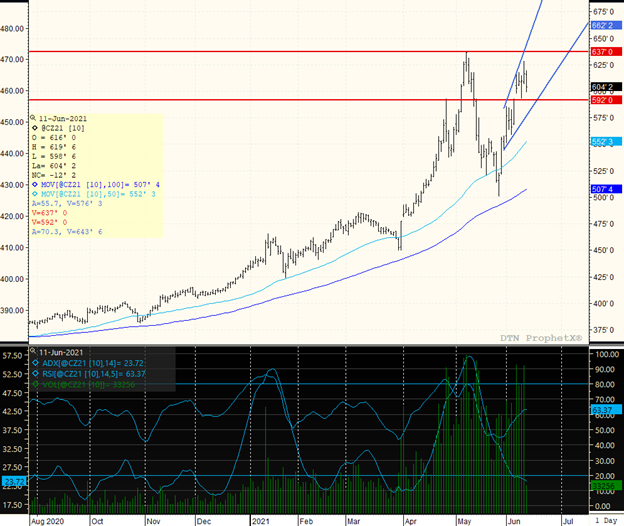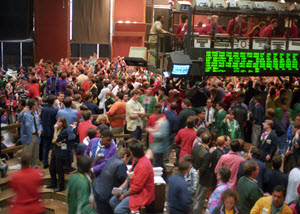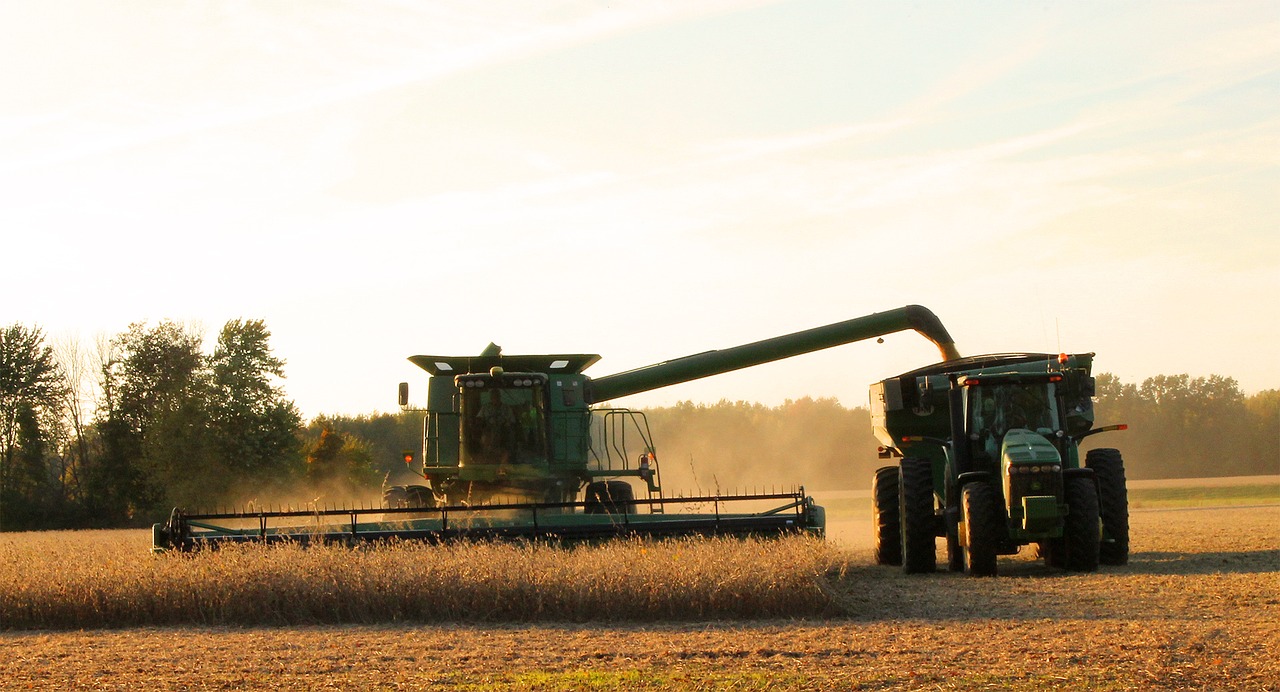GOOD MORNING,
Prices started the night on a steady note but this morning will open lower. Sharply lower soyoil futures are pressuring beans, and prices will begin on key support points. The theme now seems to be liquidation for the day into the weekend, as the report is digested from yesterday along with current weather.
China lowered its 20/21 corn estimates in feedstock on the back of more alternative use of grains. China's 202/1 corn consumption in feed was seen at 182 mmt, down 3 mmt from the prev. month, according to a statement published on the website of the Ministry of Agriculture and Rural Affairs.
The gist of the USDA report was that of a slightly friendly tilt to corn, neutral to perhaps a bit bearish for beans, and neutral for wheat. The Commitment-of-Traders report will be released after the close and is expected to show funds long an estimated 280K futures/ options corn contracts, long 145K beans, long 85K soyoil, long 20K meal, and short wheat.
Corn bulls were rewarded by the USDA June WASDE data, with the primary focus that of Brazil production. While the USDA is now at 99 mmt vs. 102.0 mmt in May, private estimates are well under that, and that will keep corn prices supported on technical breaks. Other bullish surprises for corn included the aggressiveness of the increase in ethanol grind and exports. Some traders think the USDA is still too low on corn exports.
Beans trade is lower overnight with profit-taking in oilshare. All in all the bean numbers, though greater than expected, remain tight. Old-crop stocks-to-use ratio is at a tight 2.96%, and that grows to 3.5% for new crop. Crush was lowered in the USDA report but margins have been improving, and that may suggest that crushers will likely be more active moving forward. The Goldman Roll will conclude this week, and in its wake the inverse has collapsed sending July/Nov beans down to 84 3/4c from 88 1/4c, and values that at the highest were over 2.00c. A softer domestic basis and liquidation hurts July beans, but November beans should continue to see support on weather uncertainty. Crushers continue to crush for soyoil, and in the process excess meal has to find a home as commercials typically do not store meal. As such, meal prices edge down to the lowest end of the trading range and threaten to post new lows still.
Soyoil futures are leading the way lower as funds decide to book some profits. Soyoil prices break recent lows at 70c July, leading to a larger break to the bottom of an uptrend channel with the lows of the session. In the crop report, the smaller crush reduced oil production for old crop by 135 mln to 25.380 bln lbs, imports were lowered by 50 mln, FFI was increased by 225 mln, and exports were lowered by 400 mln resulting in a 10 mln lbs reduction in ending stocks to 1.808 bln lbs, reducing new crop carry-out by 10 mln to 1.503 bln lbs. Meal production was lowered by 200 to 51,559 tst which was offset by a 50 tst increase in imports and 150 tst reduction in domestic disappearance.
Wheat trade was neutral but funds may be slightly short in this market. 21/22 saw global production raised with better production out of Russia, but current forecasts are leaning warm and dry, and this needs to be watched. Feed increased 10 mmt as expected.
WEATHER
--Rains pushed through the Dakotas this week but the forecast's upcoming return to warm and dry again over the next 10- 14 days. Rains in North Dakota do not look good moving forward. Western areas will continue to suffer stress in the heat, though a front moving through late this week and into the weekend could bring better chances of showers. Building concerns remain for areas of Neb., Minn., Wisconsin, and Michigan, with best rains for the 11/15 day period. Conditions in the Delta remain favorable for crop development.
REPORTS
USDA weekly broiler hatchery data found a modest expansion in egg sets both WOW and YOY.
ANNOUNCEMENTS
Paraguay's USDA update forecasts bean exports for 20/21 to reach 6.6 mmt and bean production to reach 9.90 mmt for the current crop cycle, down compared to 10.1 mmt for 19/20. The lower numbers are due to low water levels. Last year Paraguayan exporters faced severe logistics issues as they tried to ship beans via the Parana River amidst the lowest levels on record.
The BA Exchange reported nationwide 20/21 corn conditions at 41% good/excellent vs. 49% week ago. Corn is 37.8% riveted vs. 34% week ago, and vs. 61% week ago.
Russia's Sovecon reported it has raised the 2021 wheat crop by 1.5 mmt to 82.4 mmt.
CALLS
Calls are as follows:
beans: 10-12 lower July, 20-21 lower Nov.
meal: 1.20-1.50 lower
soyoil: 220 -230 pts lower
corn: 9-12 lower
wheat: 4-6 lower
OUTSIDE MARKETS
Crude at $70.80/barrel, with the US dollar firmer at 90.37. Stocks are up 90 pts.
TECH TALK
- July corn prices are working in a wide sideways pattern with channel support at the bottom at $6.75 and upper resistance at $7.18. The trade to $7.17 was at the top of the uptrend channel, and did hold a rally. Look to stay in this wide range as the market considers summer weather, but for the day the trade to interim support at $6.85 may hold for further consolidation.
- July wheat price pattern is simply stuck sideways from double lows of $6.72 to $7.02. For the day prices begin right at support at $6.75, and a break of this level again could find prices heading to $6.60. Since the range has been from $6.70-$6.90 for July wheat, if wanting to be short would prefer to break $6.75 solidly before selling.
- July bean chart has now turned sideways/lower, breaking trendline support at $15.45 which turns prices lower. On a weaker start, would look for the possibility of trending down towards the 50-day moving average of $15.12 if $15.25 cannot hold. November bean chart is sideways, but has formed multiple tops at $14.65 which now become stiff resistance. Prices have trendline support at $14.25-$14.30 and would look to probably test it.
- July meal chart shows the weakest price activity, now trading through $380.00 and to the downside of channel support at $380.00. Resistance moves down to $385.00, and would look to continue to trend lower, or at least test the lows of the move at $378.30.
- July soyoil futures is sharply lower, and is now turned lower from sideways to test the bottom of its uptrend channel with trade towards 68c. If needing to price, this is a good opportunity given where prices have been, though falling under the uptrend channel implies we can target 6750c again.
DECEMBER CORN
Clearly in a sideways price pattern now from $5.90 - $6.30, though trade under $5.90 does not find support until we reach trendline at $5.75. The ADX has fallen to 23, (anything under 25 denotes weak trend), so would look for this pattern of trade to continue. The rally yesterday did not stick, but perhaps the high trade keeps intact the gap-fill area now at $5.90 as key support. The spike high and reversal trade back towards $6.00 does suggest there is some weakness here. On a weaker start would look to test $6.00 to see if it can hold.

TAGS – Feed Grains, Soy & Oilseeds, Wheat, North America



 Friday’s strength in CBOT and broader global ag commodity futures was simply a foreshadowing of the rallies that would develop on Monday. Heading into the weekend, markets were jittery on perceived weather risks, many of which turned out to be prescient. Over the weekend, parts of the U.S...
Friday’s strength in CBOT and broader global ag commodity futures was simply a foreshadowing of the rallies that would develop on Monday. Heading into the weekend, markets were jittery on perceived weather risks, many of which turned out to be prescient. Over the weekend, parts of the U.S...
 Update for 1 April 2024: Last year, users pointed out differences between the 5-year averages reported in this app and what USDA estimates in its weekly report. The difference exists because WPI calculates average based on the last 5 years of observations for the current week. In cases where ob...
Update for 1 April 2024: Last year, users pointed out differences between the 5-year averages reported in this app and what USDA estimates in its weekly report. The difference exists because WPI calculates average based on the last 5 years of observations for the current week. In cases where ob...
 Trading Waste Rich Westerners consumed so much plastic that even though landfills take much of it, their export of plastic waste now overwhelms Asia. Then Western policymakers gave yellow grease (used cooking oil) a very low carbon score for use as energy since it is a form of recycling. With h...
Trading Waste Rich Westerners consumed so much plastic that even though landfills take much of it, their export of plastic waste now overwhelms Asia. Then Western policymakers gave yellow grease (used cooking oil) a very low carbon score for use as energy since it is a form of recycling. With h...